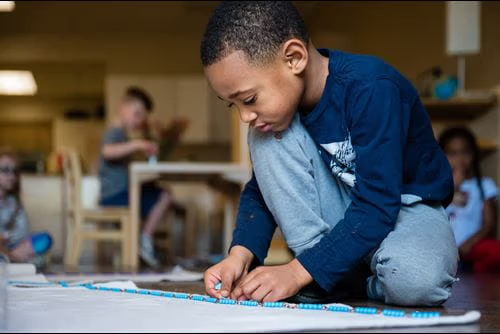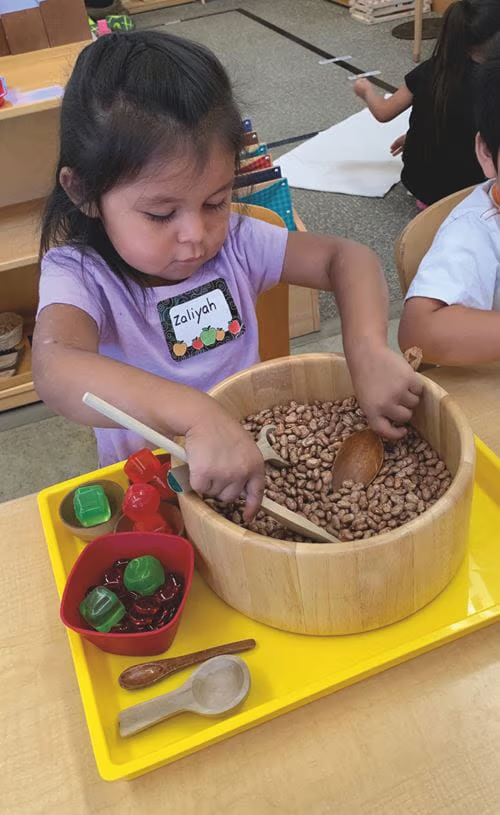This Article first appeared in our summer 2012 Issue of Montessori Life magazine. AMS members receive a print subscription to Montessori Life magazine. Become a member today.
The subtitle of this article says it all. Montessori practices, which foster “21st-century skills,” may have been modified by COVID-19–required protocols, but as we cautiously move toward a post-pandemic normal, Martha Torrence reminds us of the specific ways that “the school reform we are so eagerly trying to achieve is already a part of the contemporary educational scene in the form of Montessori education.” We must revisit the still-good reasons Montessori is a relevant, meaningful, practical, and ambitious response to the challenges of education today.
This article offers what Martha calls “potent samples” of Montessori key concepts: child- (not teacher-) centered programs, multiage groupings and 3-year cycles, intrinsic motivation and self-directed learning, classrooms as communities, uninterrupted work times that support executive function skills, and a global perspective fostered by the Cosmic curriculum. In the spirit of Montessori’s “laboratory of experimental pedagogy,” these still-timely ideas are open to updating. Montessorians in 2021 are demonstrating and responding to a mounting awareness of social justice as an urgent and elemental component of Cosmic education, Peace education, Grace and Courtesy, and social-emotional learning. Now, more than ever, Montessorians believe that children are the way to peace and social change.
—Robyn Breiman, Co-Director, Montessori Elementary Teacher Training Collaborative
“There is no force greater than that of an idea whose time has come.”
—Victor Hugo (1877)
Twelve years ago, we slid across the millennial threshold into the much-anticipated 21st century. We did so with optimism, hope, anticipation, and a reasonable measure of angst. Beyond the initial relief (computer systems held fast and the apocalypse failed to materialize), pundits of all description made, and continue to make, grand predictions about a range of global changes in the new age, on subjects varying from climate change to world population growth to the globalization of economies. The Industrial Age, it was generally agreed, was now a dinosaur lumbering toward extinction; the recently hatched term “Information Age” became the new framework for an era in which ideas and data offered more promising job prospects than assembly lines and production of consumer goods. In educational circles, the raging question was (and is): In this new Information Age, what future will our students face, and how can we best prepare them for it? What changes to the educational landscape are essential in order to prepare them?
Educational institutions change slowly, and sometimes superficially at best. Large public (and sometimes smaller private) systems can be highly resistant to deep change. Schools are notorious for rearranging the desk chairs for a while (remember the open classrooms of the 70s, where teachers continued to teach the same subject matter in many of the same ways despite a dramatic change in school infrastructure?), then reverting back to something very close to the original design. Even the most well-intentioned of educational innovations can at times do more harm than good. The 2001 landmark No Child Left Behind legislation, slated to even the playing field in American education, has instead become an excuse to test children relentlessly, powerfully forwarding the notion that the only knowledge that is worth gaining is testable and measurable, and that successful students are repositories of knowledge rather than processors of information, creative thinkers, and problem solvers. Such change-resistant constructs as age-specific grade levels, the division of curricula into discrete subjects (read: Henry Ford’s assembly line in Flint, MI), teachers as knowledge dispensers, and learning as a competitive boxing match between children (Some of you do a good job! And some of you, well…) have persisted since the Industrial Age.
Enter the new millennium and serious discussion among educators, corporate executives, government leaders, and entrepreneurs regarding the skills, knowledge, and expertise today’s students will need in order to succeed in their future jobs and, indeed, in life. This complex set of competencies, now termed “21st-century skills,” includes not only knowledge in core areas but also technological prowess, environmental literacy, cross-cultural communication skills, and the ability to solve complex problems, think creatively, and work collaboratively. Children, future citizens of the world, will need to think across disciplines, reach across cultures, and embrace new knowledge at every stage of their lives.
If traditional schools wish to prepare children for their futures (rather than the lives their parents and grandparents faced), they will need to dramatically retool curricula and pedagogy and reframe priorities. To achieve the desired results, discrete strands of curriculum (20 minutes of math, 30 minutes of science, etc.) must now be thoughtfully interconnected; age-specific grade levels must become communities of learners; rote memorization must give way to the use of knowledge to solve real-world problems; competition for grades and prizes must shift to collaboration with classmates; learning must become student-centered and driven by inquiry rather than imposed by textbooks; and the role of the teacher must become that of skilled coach rather than central knower and dispenser of information. The student, or child, becomes central to the process and an active co-constructor of knowledge rather than a passive vessel waiting to be filled.
If the above description of the new school reform movement is beginning to sound familiar to those who are knowledgeable about Montessori tenets, that is because many of these seemingly radical reforms accurately describe what has been going on in good Montessori classrooms for decades. One hates to sound smug (and trust me, there is still work to be done in the Montessori domain), but I suggest that the school reform we are so eagerly trying to define and achieve is already a part of the contemporary educational scene in the form of Montessori education.

But wait, you may ask, can a methodology that has been around for 100 years possibly satisfy the needs of today’s learners, moving them toward unknown futures and rapidly evolving contexts, complications, and technologies? A comparison of key practices in Montessori education with those advocated by the “21st-century skills” proponents indicates yes. Yes, with a few caveats, but nonetheless, an emphatic yes. While the scope of this article does not allow for a detailed and exhaustive summary of all the ways Montessori education moves us into (and hopefully beyond) the 21st century, it may serve to offer potent samples.
Let us first look at the very center of the Montessori classroom. This center is not the teacher, font of wisdom, seated in front at an imposing desk. This center is the child. Dr. Montessori said, “There was no method; there was only a child” (1966, p. 136). She began with no fixed a priori knowledge or theory of a full-throttle curriculum and a carved-in-stone methodology. Rather, Dr. Montessori started from the notion that the child is actually the center of education and that all practice should build on that core. From this comes the catchphrase “Follow the child.” And from this we realize that one of the teacher’s most essential roles is that of observer; an observer of life, which manifests itself through the development of each human potentiality. This moves the teacher from the role of “chief knower” and dispenser of knowledge, to that of guide, supporter, facilitator, and coach. The role of the adult as guide, and this open stance in the face of knowledge, are essential in the educational paradigm of 21st-century skills. One cannot both pretend to know all that is known and usher students toward their own discovery of vast, unknown worlds. Respect for the learner and their potential is absolutely central to the new educational paradigm. Montessori got this right from the start.
Next, look at the multiage classrooms that are essential to the Montessori approach and the benefits they offer, especially in 21st-century classrooms that are based on knowledge acquisition in order to pass a test. These classrooms nurture the kind of inquiry that feeds a lifetime of learning. At every phase of the Montessori progression, we have 3-year cycles, which offer the opportunity to be a beginner, or an upstart novice, who notices and begins to internalize that which is to come by observing those who are older and more experienced. In the middle are the second-years, the sophomores, who know the ropes and test their mettle against more advanced materials and complexities. These are the friends who go out of bounds a little bit and can act quite silly; they are also the experimenters and bold adventurers of the room. Next are the seniors, or third-years, those who are integrating past knowledge and externalizing it in the form of huge and complex new works and exploding new abilities (think of the 5-year-old who is eagerly beginning to read or the 12-year-old who is completing a complex research project) and leadership skills. What better environment could be imagined to support the development of communities of collaborative learners, learners who find it natural and even essential to consider the ideas of others, even others who are different from them, when solving a complex problem?
Consider now the overall attitude toward knowledge that is exemplified in a Montessori classroom. Each child moves at their own pace, progressing to new materials, skills, and concepts as he or she is ready. Each child has the opportunity to choose materials from within a given range; this supports the development of intrinsic motivation and self-directed learning, both of which are key ingredients in the mix of becoming a lifelong learner in a world where learning and knowledge have no end. Montessori classrooms favor error as a step toward such self-directed learning and offer built-in “controls of error” within each material so that the learner can reflect on his or her “mistakes,” developing problem-solving skills through the discovery and correction of the same. This stands in contrast to seeking out the “right” answer from the teacher, panicking over incorrect answers on a test, or cheating in order to do well, all according to someone else’s standards.

Consider as well the notion that the classroom is a community in which social problems arise naturally. And these problems are resolved naturally, through use of conflict-resolution skills taught and practiced on a daily basis within the context of a supportive social environment. Montessori teachers share what are quaintly referred to as Grace and Courtesy skills from the earliest age: how to say good morning and look someone in the eye; how to accept or decline an invitation; how to politely interrupt someone; how to walk carefully and respectfully around another’s work so that they are not distracted. When conflicts arise, and they inevitably do, children learn to clutch the peace stone or use some other procedure to assertively but respectfully state their feelings or thoughts, and then (and this is critical) they listen to the thoughts, feelings, even passions, of others. Older children, moving beyond the “I,” learn to resolve group problems and find solutions that make sense for all. Middle schoolers learn that disagreement is essential to taking multiple perspectives and finding consensus, and discover ways to move forward with a project even with divergent points of view strongly felt. For meaningful collaboration, one needs to learn to gracefully appreciate another’s point of view and find common ground.
In Montessori classrooms, from Toddler through High School levels, students make active choices about the work they find most compelling at a given time. And they are afforded long, uninterrupted activity cycles in order to deeply explore this work, to engage with it, to pose problems and resolve them through self-directed activity. No reward is greater than a child’s sense of inner victory over a problem solved or a complex work completed. There are no gold stars, no prizes—just a deep love of process and outcome, and the quest for further knowledge.
Montessori children begin to develop a global perspective from the youngest age. Handling the land and water globe gives way to continent studies, which give way to the “Cosmic curriculum” of the Elementary years, in which students develop an appreciation for the oneness of things, the awareness that everything has a “cosmic task,” and that all things, living and nonliving, are interconnected. As the child deeply absorbs this integrated curriculum, they develop a strong sense of being a citizen of the world and a steward of its precious resources.
Through the gradual development of self-discipline through active engagement in an environment where “freedom within limits” is the rule of the realm, children develop a sense of their own responsible place within the greater scheme of things. We all have rights; we all have responsibilities. As children (and their senses of ethical and moral rightness) mature, they more consciously develop a sense of compassion, a sense of respect for the complexity of living and nonliving things, a sense of justice, and an ability to weigh priorities in the use of resources.
The spiraling, interconnected curricula that begins with the youngest child’s experience of concrete materials and advances, one awareness and skill at a time, to the older child’s reach toward such abstractions as congruency, place value, decimal fractions, expository writing, peace, and sustainability, is a major, mind-numbing gift of this method. Children do not need to memorize for the test; they assemble constructs from the inside out. They know. Montessori teachers use a wide range of assessment tools to ascertain what their children know and understand. Some of these assessment tools are tests, but most of them are more authentic, performance-based tools. Children demonstrate their knowledge every day by applying it.
Are there things that we, as Montessorians, can work on, do better, as we march more deeply into the 21st century? Of course. In my opinion, we could engage our children in more projects of a deeper nature. We could muck about more, especially in the sciences, in Early Childhood and Lower Elementary programs. We can pay more attention to the serious topic of play as a human construct; this most essential of collaborative skills strikes to the heart of the 21st-century need to create, explore, and collaborate. And the technology issue is a potent one. How much? What kind? At what ages? We can explore these modalities in the spirit of Dr. Montessori, who stated, “I believe that I have by my method established the conditions necessary to the development of scientific pedagogy; and whoever adopts this method opens, in doing so, a laboratory of experimental pedagogy” (Montessori, 1964, p. 370). Dr. Montessori knew that her work was not complete, nor could it ever be. Her legacy to those of us who work every day in Montessori education is the gift of roots and wings: Our roots are held firmly in the deep, rich soil of Montessori tenets that have served many thousands of children from all parts of the globe for the past 100 years. Our wings lift us and our children into a future of ever-expanding challenges, wonders, and possibilities.
MARTHA TORRENCE, MEd, is head of school at Summit Montessori School in Framingham, MA, and president of the Montessori Schools of Massachusetts. She served on the AMS Board of Directors for 11 years, including 1 year as president. She is AMS-credentialed (Early Childhood). Contact her at mtorrence@summitmontessori.org.
References
Hugo, V. (1877). Histoire d’un crime. Paris: Calmann-Lévy.
Montessori, M. (1964). The Montessori method. New York: Schocken Books.
Montessori, M. (1966). The secret of childhood. Notre Dame, IN: Fides Publishers.


